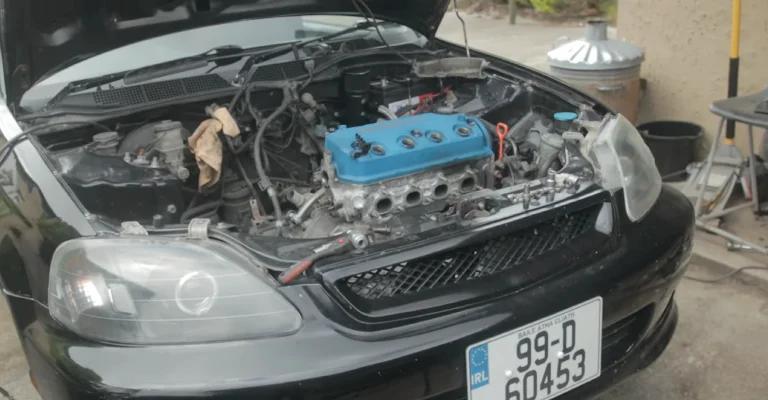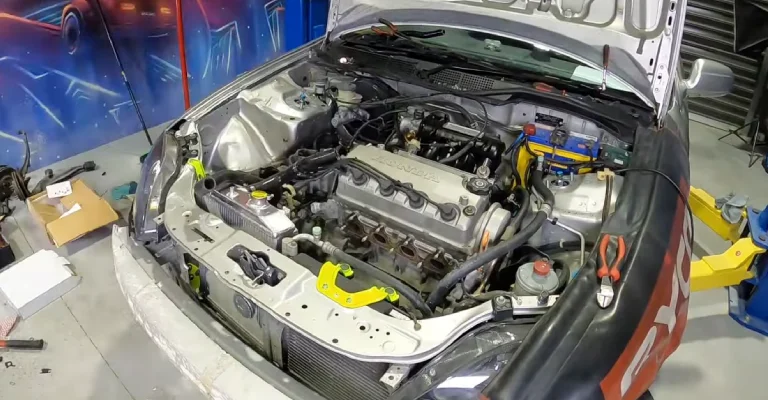The Honda D16Y7 engine is a 1.6 liter, 4-cylinder, SOHC (single overhead cam) engine that was produced by Honda Motor Co. Ltd.
It was first introduced in the 1992 model year, and was commonly found in Honda Civics and Del Sols until it was phased out in 2000.
The D16Y7 engine is known for its fuel efficiency, reliability, and compact size, making it a popular choice for those looking for a reliable and efficient engine for their Honda vehicle.
This engine is a good option for those who want a balance between power and efficiency.

Honda D16Y7 Engine Overview
The engine belongs to the Honda D series engine family. A Honda engine that starts with a “D” has an inline-four cylinder configuration that has a displacement between 1.2 and 1.7 liters. In 1984, production of the D series began, and it ended in 2005.
In the 21 years Honda has been working on this type of engine, it has had plenty of time to work out any problems that may arise. This is one of the reasons these engines are still on the road today.
These engines didn’t utilize VTEC technology or dual overhead cams like some of Honda’s more popular engines produced in the 1990s. The D16Y7 was used in the base models of the Honda Civic and had only 106 horsepower.
Some of the vehicles that the D16Y7 engine was found in include the 1996-2000 Honda Civic DX/VP/LX/CX, 1998-2000 Honda Civic Special Edition – SE/EX (Canada), 1996-1997 Honda Del Sol S, and 1996-1997 Honda Civic Coupé LSI.
| Specification | Honda D16Y7 Engine |
|---|---|
| Displacement | 1.6 liters (97 cubic inches) |
| Bore and stroke | 75.0 mm x 89.4 mm (2.95 in x 3.52 in) |
| Compression ratio | 9.4:1 |
| Horsepower | 106 horsepower at 6200 RPM |
| Torque | 103 lb-ft at 4600 RPM |
| Redline | 6800 RPM |
| Rev-limiter | 7200 RPM |
| Valvetrain | SOHC (4 valves per cylinder) |
| Fuel Control | OBD2 MPFI |
| Head Code | P2A-2 |
| Piston Code | P2E |
| ECU Code | P2E |
| Found in | 1996-2000 Honda Civic DX/VP/LX/CX, 1998-2000 Honda Civic Special Edition (Canada), 1996-1997 Honda Del Sol S, 1996-1997 Honda Civic Coupé LSI |
The D16Y7 engine has a bore and stroke of 75.0 mm x 89.4 mm and a compression ratio of 9.4:1.
It produces 106 horsepower at 6200 RPM and 103 lb-ft of torque at 4600 RPM. The engine has a redline of 6800 RPM and a rev-limiter of 7200 RPM. The valvetrain is SOHC (4 valves per cylinder) and it is fuel control by OBD2 MPFI.
The head code is P2A-2, Piston Code P2E and ECU code P2E.
The Honda D16Y7 engine is known for its good fuel efficiency, reliability and balance between power and efficiency. It meets the emissions standards set by the EPA and CARB during the time it was produced.
The engine is considered to be a reliable and efficient option for Honda vehicle owners.
What Car Did the D16Y7 Come In?
The Honda D16Y7 engine was commonly found in the 1996-2000 Honda Civic DX/VP/LX/CX models, the 1998-2000 Honda Civic Special Edition (Canada) models, the 1996-1997 Honda Del Sol S models and 1996-1997 Honda Civic Coupé LSI models.
It was a popular choice for those looking for a reliable and efficient engine for their Honda vehicle.

Comparison to Other D16 Engines
The D16Y7 engine can be compared to other D16 engines in the Honda lineup such as the D16Y8 and D16Z6.
- D16Y8: This engine is similar to the D16Y7 but it has a higher compression ratio of 9.6:1 and produces 127 horsepower at 6300 RPM and 107 lb-ft of torque at 5200 RPM. This engine also has VTEC (Variable Valve Timing and Lift Electronic Control) which allows for increased power and efficiency.
- D16Z6: This engine has a higher compression ratio of 9.6:1, and produces 125 horsepower at 6600 RPM and 106 lb-ft of torque at 5200 RPM. It also has VTEC, which allows for increased power and efficiency.
In comparison, the D16Y7 engine has a lower compression ratio, and lower Horsepower and torque output, but it is considered to be a reliable and efficient engine.
The D16Y8 and D16Z6 engines have a higher compression ratio, higher horsepower, and torque, but also have VTEC which allows for increased power and efficiency.
Head and Valvetrain Specs D16Y7

The Honda D16Y7 engine features a SOHC (single overhead cam) design, which means that there is one camshaft located in the cylinder head that operates the valves.
The engine has 4 valves per cylinder, two intake valves and two exhaust valves. The head code is P2A-2 and the valvetrain is SOHC (4 valves per cylinder).
The valvetrain is designed to be lightweight and low-friction, which helps to improve engine efficiency and power output.
The D16Y7 engine does not feature VTEC (Variable Valve Timing and Lift Electronic Control) system, which other D16 engine models have.
What Upgrades and Modifications Possible to Honda D16Y7 engines

Upgrades and modifications that can be done to a Honda D16Y7 engine include:
Cold air intake:
This will increase the amount of airflow to the engine, providing more power.
High-performance camshafts:
These will increase the engine’s power by optimizing the valve lift and duration.
High-performance exhaust:
A high-performance exhaust will increase the engine’s power by reducing backpressure.
High-performance throttle body:
A larger throttle body will allow more air into the engine, increasing power.
High-performance fuel injectors:
Larger fuel injectors will allow more fuel to be delivered to the engine, increasing power.
High-compression piston:
This will increase the engine’s compression ratio, providing more power.
Forced Induction:
Turbochargers or Superchargers can be added to compress the air going into the engine, providing more power.
Engine tuning and remapping:
This will optimize the engine’s performance by adjusting the fuel and air ratios.
It’s important to note that some of these modifications may require additional upgrades such as stronger connecting rods and pistons and a high-performance engine management system to support the increased power.
Most Common Problems With Honda D16Y7 Engines
The most common problems with Honda D16Y7 engines include:
Timing Chain Tensioner Failure:
This can cause the timing chain to become loose, resulting in poor engine performance or engine damage.
Oil Leaks:
The D16Y7 engine is known to develop oil leaks from the valve cover gasket, front crankshaft seal, and timing cover.
Head Gasket Failure:
This can cause coolant to mix with the engine oil, resulting in poor engine performance or engine damage.
Clogged EGR Valve:
The Exhaust Gas Recirculation (EGR) valve can become clogged with carbon buildup, resulting in poor engine performance or a check engine light.
Throttle Body and IACV (Idle Air Control Valve) problems:
These can cause rough idle, stalling, or poor engine performance.
O2 Sensor Failure:
This can cause poor fuel economy, poor engine performance, and a check engine light.
Distributor Failure:
This can cause poor engine performance, stalling, and a check engine light.
Fuel Injector Clogs:
This can cause poor engine performance, misfires, and a check engine light.
It’s worth noting that these are common issues with many engines, and specific issues can vary based on the mileage, usage and maintenance history of the vehicle.
The Beginning Of The OBDII Era
From 1996 onwards, the D16Y7 engine replaced the D15B7, which was available from 1992 to 1995.
From 1996 onwards, Honda Civics would be powered by 1.6L engines instead of 1.5L ones. The D16Y7 gained 4 horsepower from this upgrade.
As a result of new emission laws beginning in 1996, new Onboard Diagnostic (OBD-II) systems were required for all American cars. Today’s engines are equipped with the same OBD-II system that was installed on the D16Y7 engine.
Honda Civic engines with this engine were used in DX, LX, and CX models and were not considered high performance.
Compared to the 1996-2000 Honda Civic EX’s D16Y8 VTEC engine, which produced 127 hp, the D16Y7 engine had only 106 horsepower.
The D16Y7 was replaced by the D17A1 in 2001. In addition to increasing the displacement to 1.7L, Honda also increased the overall horsepower to 115.
Final Words
There are still many Civics on the road today powered by the D16Y7 engine. In the same time period, Honda’s VTEC engines displayed better performance than this engine.
Although this engine had only 106 horsepower, it was designed for good fuel economy and durability rather than performance.
Furthermore, it was equipped with both OBD-II emissions control technology and catalytic converters, making it one of the first Honda Civics to do so.

Leave a Reply